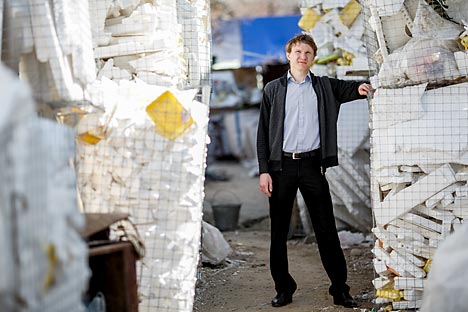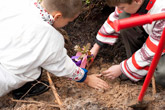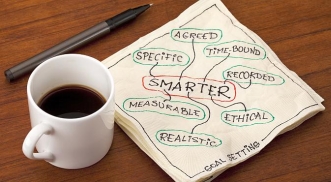Eco building of trash can be profitable

Roman Sebekin: "Everybody was looking for ways to save money, and our blocks and tiles are a great alternative to conventional building materials". Source: RIA Novosti
Roman Sebekin, a Volgograd native, decided to start a business with an environmental and, for Russia, unusual theme: He created a company for transforming recycled plastic waste into building blocks and materials. In an interview, Sebekin talks about the characteristics and prospects of his enterprise.
Hopes & Fears: How did it all begin?
Roman Sebekin: I have read a lot about plastic recycling technology and seen many programs about foreign companies that specialize in the recycling of waste products and subsequent construction. In 2003, when I became enthusiastic about my idea, there were no technologies ready for it — but Volgograd is an industrial town.
You can even build a tank [here]; you only need to know how to put it together. I began to think over the technology and the equipment and, traveling all over Russia in search of materials and development, studied production. I spent a lot of time and energy in order to start the company, and, in 2004, I succeeded in doing it.
HF: How is the recycling done?
R.S.: Plastic is cut, mixed with sand and water, and then pressed. This is a very simplified description of the process. Processing is carried out fairly quickly: The finished product is obtained in 2–3 hours.
Ten cubic meters [or 353 cubic feet] can be used to make 300 plastic construction blocks. Our processing capacity is 10,000 cubic meters per month — that's about three single-story houses of 100 square meters [or 1,076 square feet] each. We have presented our technology to various agencies; our units have passed the state examination and received a certificate of quality.
All of the equipment that I use is domestic, but there is little left of the previous models, as I had them completely rebuilt.
HF: Where do you get the plastic for recycling?
R.S.: The company uses all methods possible to collect plastic. Sometimes, residents bring plastic waste; part of it is collected from the containers set up throughout the city.
HF: Who buys your products? How do you find new customers?
R.S.: This is not the first year that we have been on the market. We have regular customers, but, so far, these are only individuals. It would be beneficial to go out into the corporate sector, as company orders are on a larger scale [there].
However, individual clients helped us survive through the crisis of 2008. Everybody was looking for ways to save money, and our blocks and tiles are a great alternative to conventional building materials.
Related:
Ten Russian cities that need air-quality clean up Ten Russian cities that need air-quality clean up
Many clients come to me on referral. Gradually, it spread by word of mouth: Someone builds a house using our materials; he is happy with them, and he then recommends them to his neighbors. However, it was not always so. There were times when we were faced with distrust. People were skeptical about the new recycled materials, but not anymore.
In its aesthetic characteristics, a house built with plastic blocks is not inferior in any way to a usual house. As for its energy-efficiency, it is even superior. The polysterol blocks retain heat. In addition, they are cheaper: They cost 30 rubles [$1] a piece, while the building blocks cost 60 rubles.
HF: In addition, there is a benefit for the environment.
R.S.: Yes, but when I started in this business, I did not think so much about the environmental component. At first, it was necessary to solve the clear objectives — to build a home and create high-quality material that would not make me blush.
But now my basic principles are precisely in the area of ecology. We are fighting environmental illiteracy. Recently, we have been able to set up containers for separate waste collection in different parts of the city, including daycare centers and parks. I think that people should be taught to separate their garbage and to respect nature from childhood.
HF: What other goals do you set for yourself?
R.S.: Our main task now is to produce plastic crossties. The equipment is almost made: All we have left is just to make the product and send it out for testing to the Russian Railways Scientific Research Institute. We are taking a big bet on eco-friendly crossties: Many people already realize that the future is in plastic, and concrete and other materials belong to the last century.
Another project deals with the organization of an environmental fund. I recently applied for its registration. [The fund] will have to help eco-friendly enterprises not only here in Volgograd, but all over Russia.
The main assistance will be to provide grants; we have already found sponsors who will provide the material component. In addition, the fund will help collect and distribute recycling technology.
First published in Russian in Hopes & Fears.
All rights reserved by Rossiyskaya Gazeta.
Subscribe
to our newsletter!
Get the week's best stories straight to your inbox

